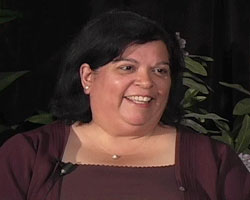Covering the Beat Less Traveled
A Hechinger Institute fellowship program focuses on community colleges
Gloria Padilla, an editorial writer at the San Antonio Express News, makes no secret of why she's so interested in writing about community colleges-she attended one herself.
A first-generation college student from a family of 12 where English was a second language, Padilla spent a year at
Now Padilla is one of six fellows and nine associates participating in the "Covering America, Covering Community Colleges,'' a fellowship offered by TC's Hechinger Institute on Education and the Media. All 15 spent the first week in October at Teachers College learning more about community colleges and gathering research for major projects.
"We want to encourage, support and reward in-depth reporting on community colleges," says Richard Colvin, Director of the Hechinger Institute, adding that there is insufficient reporting on these institutions, which serve the bulk of the nation's poor and minority college students. Colvin's goal is to "help Americans become much more aware of how important community colleges are in this country."
Jim Jacobs, Associate Director for Community College Operations at TC's Community College Research Center (CCRC), which is co-sponsoring the program, agrees that community colleges get very little media attention.
"Half of the undergraduates in the
"What Hechinger is doing is extremely useful for good journalism and more accurate stories about education by focusing attention on a segment that has not received that much attention in the past,'' Jacobs adds. Participants in the program, supported in its first year by the Lumina Foundation and by the Lumina and Hewlett Foundations in its second year, were selected from a pool of more than 50 applicants based on detailed proposals.
The six fellows are employed by newspapers ranging in size and stature from USA Today and the Philadelphia Inquirer to the Contra Costa [California] Times and Lansing [Michigan] State Journal. The group will have four months to research, write and eventually publish stories that report on their various community college-related topics. That four-month period began in October with a six-day seminar in
During the seminar, the fellows and associates received a broad overview of community college issues ranging from policy and finance to data and demographics. The fellows heard from seven presidents of community colleges, TC researchers and faculty members, along with journalists from the Los Angeles Times, Washington Post, Inside Higher Education and the Wall Street Journal.
They also took field trips to
While all 15 participants received a fully paid trip to the
When something more pressing comes up, she added, such projects take a back seat. For just that reason, the Hechinger Institute required the participants' editors to sign a contract indicating their commitment to the stories.
Padilla's proposal focuses on an effort in
The program's goal was to increase student enrollment in
According to Padilla in her detailed proposal, although the number of Hispanics earning degrees at
Published Friday, Nov. 16, 2007
